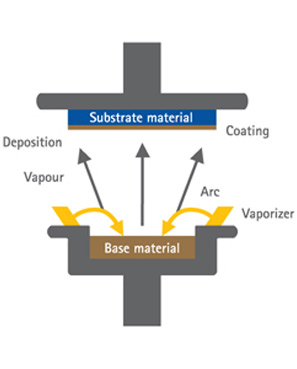In the area of commercial metal coatings, physical vapor deposition, or PVD is becoming a popular process for metalizing a product. Metalization is simply the process of adhering a metal coating to a product. A metal coating has a number of desirable traits for product finishing. It is reflective, protective and can be used as an electrical conductor.

How PVD Works
A substrate, or the product to be coated, is placed in a vacuum chamber. The metal coating is evaporated through a thermal process and the vapor is deposited onto the substrate in a low temperature environment. When the evaporated metal is removed from the vacuum chamber and returns to its solid state, the result is a hard, uniform, thin metallic coating on the substrate.
A large variety of metals can be used in the PVD process to provide a metal coating. Aluminum may still remain the most popular metal, due to its high reflective properties and strength to weight ratio. But many other metals can be vaporized and deposited. Copper, steel and other metals may also be used in the process. With chrome finishes, a PVD application can often dispense with the need for a top coating, meaning less chemicals are used. In addition, there is no top clear coat to fade or haze over time.
Because the process does not require an electrical charge, such as electroplating, the product substrate need not be capable of conducting electricity. This allows for a wider range of products to be given a metallic finish. In many products requiring a reflective finish, such as lighting fixtures, substituting plastic for metal substrates can greatly reduce the final cost of the product.
Uses for PVD Metal Coatings
Metal coatings have been used for years, and the uses are virtually endless. A few examples of applications for PVD coatings are:
• Heat shielding;
• Chrome finishes, including bronzed and gold plated surfaces;
• Light reflectors;
• Mirrors;
• Reflective glass;
• Protective Vapor Barriers;
• Shielding for Electrical components;
For those with a product in need of a metallic coating, consider a manufacturer with experience in the field. Because coatings are thin and tolerances for errors are low, look for a company that provides regular inspections and testing during the process. In this area, an expertly applied PVD process can make all of the difference in the finished product.
Learn more
In the past, it was thought that there were only a couple of metals that would actually work to create machinery for the aerospace industry, but n ...
Many people are unaware there are kits that can coat various metals and make them stronger and more durable. These kits are invaluable to certain ...
Millions of Americans want to make extra money, but few realize how much they’re throwing away. The U.S. only represents approximately 5% of the g ...
Friction stir welding is a type of solid-state joining process that utilizes a non-consumable item or tool to join two or more workpieces without ...
High levels of product quality is not only vital to the success and reputation of a pharmaceutical company, it’s also mandated by government regul ...







